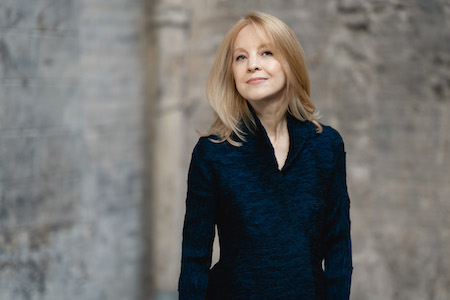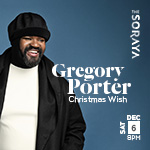Oct 28, 2025 10:47 AM
In Memoriam: Jack DeJohnette, 1942–2025
Jack DeJohnette, a bold and resourceful drummer and NEA Jazz Master who forged a unique vocabulary on the kit over his…

“I value musicians who really appreciate not playing and listening and waiting for the right moment to make their entrance,” Schneider said.
(Photo: Briene Lermitte)A year ago, Maria Schneider was, like many people, stuck in a pandemic holding pattern. With live gigs for The Maria Schneider Jazz Orchestra canceled or postponed, she was spending an inordinate amount of time in archival cleanup, reconciling discrepancies in old scores for the sake of posterity.
“I didn’t want to leave pieces of things hanging out there with mistakes in them,” she said recently. As the pandemic’s impact eased, she has turned her attention to other projects. None has been more pressing than scheduling bookings for the 18-piece orchestra, which has won Large Jazz Ensemble of the Year in the 2022 DownBeat Critics Poll, as it has every year since 2007.
After 18 months with no gigs — the longest period of inactivity in the band’s 30-year history — it reemerged at the outdoor DC Jazz Festival in September. The experience, according to Schneider, was imperfect: The set was short, the wind was unkind and a couple of tempos were a bit off. “It was a little rough,” she said.
Yet it also proved cathartic, allowing a long-awaited opportunity for the band to air material from its Grammy-winning double-disc opus Data Lords. Kinks notwithstanding, performances of pieces like “Don’t Be Evil,” “Sputnik” and the title tune offered evidence that all would be well. A few more gigs, ending with a week at Birdland in March, confirmed that proposition.
“We blew the stink off,” Schneider recalled with a smile.
The successful return was by no means preordained. A European tour set for February was called off because of a COVID spike. Beyond that, the December 2020 death of the band’s pianist and éminence grise, Frank Kimbrough, weighed heavily. The consensus replacement was Gary Versace, the band’s highly respected accordionist, but no one knew how that would alter the ensemble’s delicate balance.
“It’s hard when you have people, and your band is built around them, and they’re such a part of your sound,” Schneider said. “You’re wondering, ‘How is this going to change? Is it going to feel like a loss?’ There’s just a lot of emotions and things.
“The whole band was feeling it. I think Gary was feeling it: ‘How do I come in and now make it my own, yet still honor the kind of dynamic that we built over the years,’ which also, by the way, was built by Gary.”
For his part, Versace was realistic: “There’s a transition period to adapt to a new person and a new musical voice on the instrument, because Frank was so much a part of what the band is. So I just try to respect that.”
While Versace felt the loss as much as anyone — Kimbrough was both a colleague and friend — the accordionist’s 20 years with the orchestra equipped him with the potential to take the piano chair and make it his own.
“They both have the esthetic of being great listeners and collaborators,” Schneider said, adding that Versace “carves out every note with the amplitude of how he touches the note. It’s not just the line, not just the chord. It’s how he caresses them.”
Versace, Schneider said, not only brought a new voice to the piano but also helped ease the way for Julien Labro, who had been occupying the accordion chair, a position made trickier by the presence of a guitar in the band.
“I have a rhythm section with three chordal players — that’s a disaster, generally,” Schneider said. “So I value musicians who really appreciate not playing and listening and waiting for the right moment to make their entrance. Gary’s been helpful helping Julien find that space.”
She said Versace might lead her to try new kinds of writing for piano, and Labro, whose experience extends into the classical realm, might lead her down new avenues for accordion.
Data Lords, inspired partly by her collaboration with David Bowie and his penchant for the darker writing of her early period, represented something of a return to that mode. The album reflected her concerns about big technology companies. But that topic has, for the moment, run its course in her work.
“It’s on my mind, but I’m not I’m not making new discoveries about it,” she said. Rather, Schneider may be entering a more pastoral (if no less serious) period, like the one that reached its apotheosis with the Grammy-winning The Thompson Fields. That album drew on her childhood on a Minnesota farm.
She is at work on “The Great Potoo,” a piece about a bird she encountered on a trip to Brazil. While birds are a long-held interest, she said, she wasn’t aware that they would return as an artistic inspiration when she came up with the piece’s core motif. Yet, “After 15 years of not thinking about the potoo much, something in my head said, ‘Look up the potoo again on the internet. Remind yourself about that bird.’ When I saw it, I said, ‘Oh, my god, that’s what this piece is.’”
The bird emits a piercing sound that, in her mimicking, came across as something between a squawk and a shriek. The sound will be assigned to the trombone, she said, when she finishes adapting the work from a commission she has already produced for a group from the Eastman School of Music, where she received a master’s degree in 1985.
Other pieces about birds are also percolating in her mind, she said, all of which could ultimately coalesce into a theme for an album. But such thoughts are premature. Even as she hoped to have “The Great Potoo” in shape for this year’s Newport Jazz Festival, the band will continue to make up for lost time playing music from Data Lords.
Wherever her writing takes her, she said, she is happy with the direction of the group.
“I have a new optimism that it somehow feels OK to enjoy where it’s going and not feel that’s wrong, too, because we’ve lost Frank. Frank would want that. That’s where we are. It’s a very good place to be — a very complex dynamic.” DB

Jack DeJohnette boasted a musical resume that was as long as it was fearsome.
Oct 28, 2025 10:47 AM
Jack DeJohnette, a bold and resourceful drummer and NEA Jazz Master who forged a unique vocabulary on the kit over his…

D’Angelo achieved commercial and critical success experimenting with a fusion of jazz, funk, soul, R&B and hip-hop.
Oct 14, 2025 1:47 PM
D’Angelo, a Grammy-winning R&B and neo-soul singer, guitarist and pianist who exerted a profound influence on 21st…

To see the complete list of nominations for the 2026 Grammy Awards, go to grammy.com.
Nov 11, 2025 12:35 PM
The nominations for the 2026 Grammy Awards are in, with plenty to smile about for the worlds of jazz, blues and beyond.…

Drummond was cherished by generations of mainstream jazz listeners and bandleaders for his authoritative tonal presence, a defining quality of his style most apparent when he played his instrument unamplified.
Nov 4, 2025 11:39 AM
Ray Drummond, a first-call bassist who appeared on hundreds of albums as a sideman for some of the top names in jazz…

Jim McNeely’s singular body of work had a profound and lasting influence on many of today’s top jazz composers in the U.S. and in Europe.
Oct 7, 2025 3:40 PM
Pianist Jim McNeely, one of the most distinguished large ensemble jazz composers of his generation, died Sept. 26 at…






